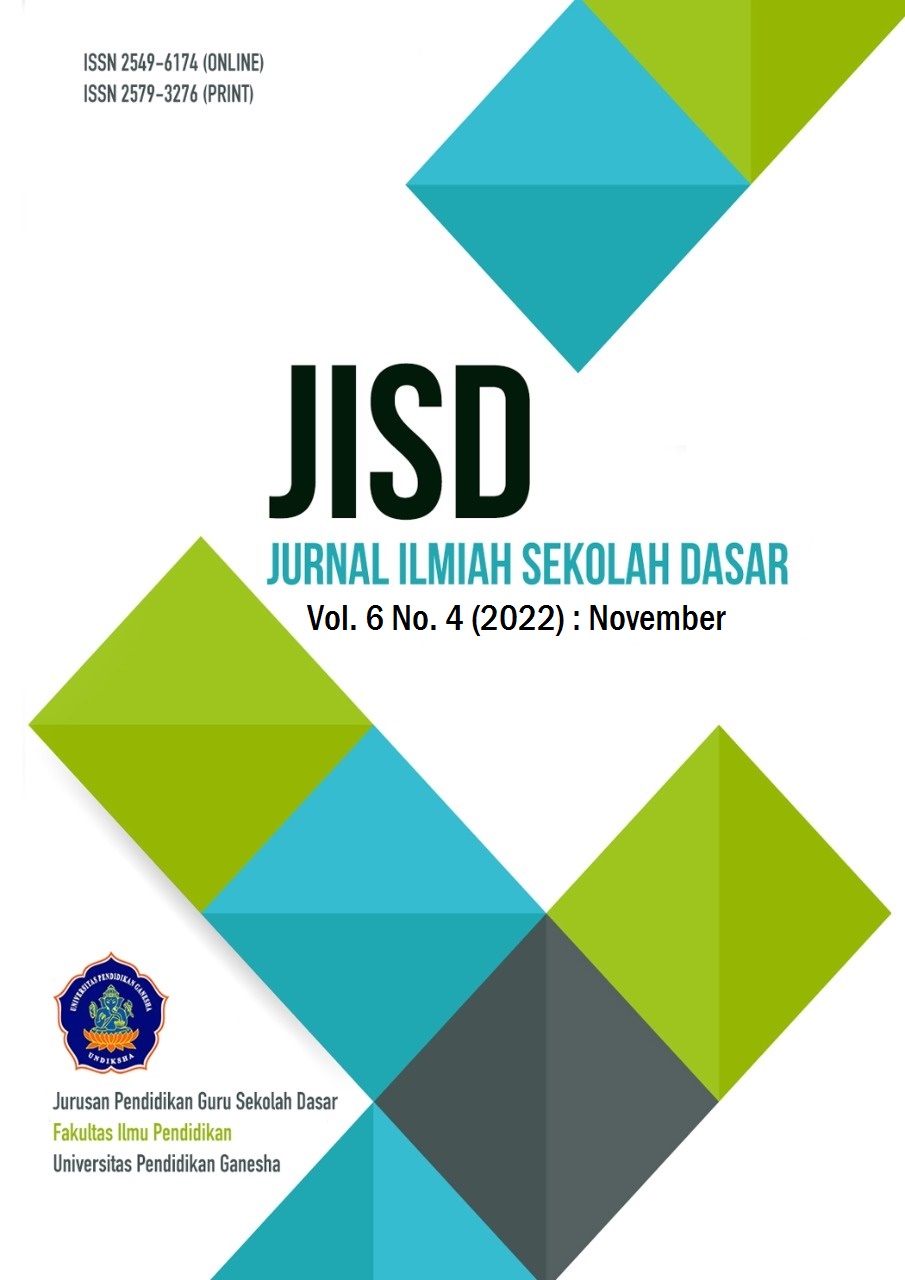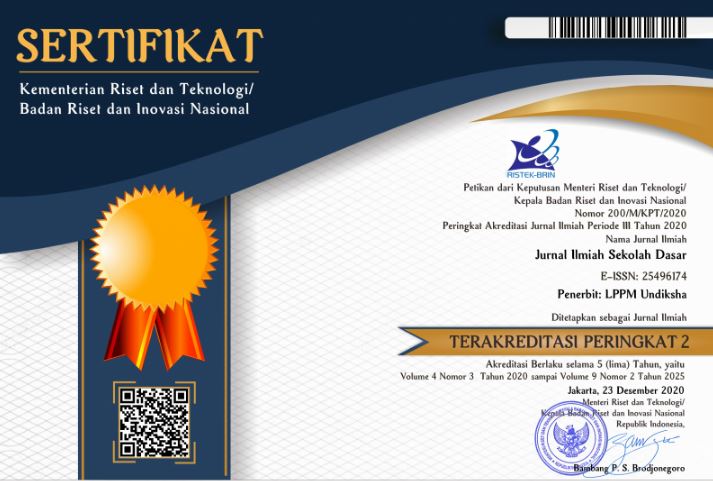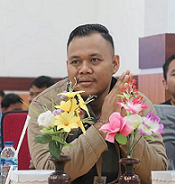PMR Learning Model as Materials of Summary of 1st Grade Students
DOI:
https://doi.org/10.23887/jisd.v6i4.55149Keywords:
Mathematic, PMR, learning modelAbstract
Mathematics education must begin when children enter school, namely at the elementary school level. The success of a student's education can be influenced by the learning approach used by the teacher. In particular, the additional lessons covered in the first grade of elementary school are very suitable for the PMR learning model. Learning to count can be facilitated by using candy-themed media and educational videos. The purpose of this study was to analyses the results of applying the PMR learning model to the educational process in relation to student learning. PTK which includes cycles I and II is the methodology of choice for this study. The PMR learning model was not implemented in Cycle I until after the pre-test was carried out. In Cycle II, we practiced the PMR learning paradigm with the help of learning videos and candy media. Twenty students from grade one at elementary school participated in this study. Data collection techniques were collected by tests and documentation. The result of this study show the average student score in cycle I was below the KKM standard. The KKM requirements were met with an average student in cycle II after the PMR learning model was applied. The findings from this study indicate that when the PMR learning paradigm is used together with learning videos and candy media, student learning outcomes show a significant increase.
References
Afriansyah, E. A. (2021). Realistic Mathematics Education Berbasis Emergent Modeling untuk Meningkatkan Kemampuan Berpikir Kritis dan Kreatif Matematis serta Curiosity Mahasiswa Calon Guru. Universitas Pendidikan Indonesia.
Afriansyah, E. A. (2022). Peran RME terhadap Miskonsepsi Siswa MTs pada Materi Bangun Datar Segi Empat. Mosharafa: Jurnal Pendidikan Matematika, 11(3), 359–368. https://doi.org/10.31980/mosharafa.v11i3.2102. DOI: https://doi.org/10.31980/mosharafa.v11i3.2102
Afsari, S., Safitri, I., Harahap, S. K., & Munthe, L. S. (2021). Systematic Literature Review: Efektivitas Pendekatan Pendidikan Matematika Realistik Pada Pembelajaran Matematika. Indonesian Journal of Intellectual Publication, 1(3), 189–197. https://doi.org/10.51577/ijipublication.v1i3.117. DOI: https://doi.org/10.51577/ijipublication.v1i3.117
Ahmad, M., Siregar, Y. P., Siregar, N. A., & Effendi, H. (2018). Realistic math-based learning model based on mandailing culture. International Journal of Sciences: Basic and Applied Research (IJSBAR), 39, 67–78. https://www.academia.edu/download/58097696/2018-04_IJSBAR_-_Activity_PMR-BBM.pdf.
Al-Zoubi, S. M., & Younes, M. A. B. (2015). Low Academic Achievement: Causes and Results. Theory and Practice in Language Studies, 5(11), 2262. https://doi.org/10.17507/tpls.0511.09. DOI: https://doi.org/10.17507/tpls.0511.09
Anwar, B., & Asriani. (2017). Penerapan Pembelajaran Problem Solving untuk Meningkatkan Aktivitas dan Hasil Belajar Matematika pada Materi SPLDV. Jurnal Pendidikan Matematika, 4(2), 224–239. https://doi.org/10.36709/jpm.v4i2.2035.
Arianti. (2019). Urgensi Lingkungan Belajar Yang Kondusif Dalam Mendorong Siswa Belajar Aktif. Jurnal Kepemdidikan, 11(1), 41–62. https://doi.org/10.30863/didaktika.v11i1.161. DOI: https://doi.org/10.30863/didaktika.v11i1.161
Bandur, A., Hamsal, M., & Furinto, A. (2022). 21st Century experiences in the development of school-based management policy and practices in Indonesia. Educational Research for Policy and Practice, 21(1), 85–107. https://doi.org/10.1007/s10671-021-09293-x. DOI: https://doi.org/10.1007/s10671-021-09293-x
Cahyadi, A., Hendryadi, Widyastuti, S., Mufidah, V. N., & Achmadi. (2021). Emergency remote teaching evaluation of the higher education in Indonesia. Heliyon, 7(8), e07788. https://doi.org/https://doi.org/10.1016/j.heliyon.2021.e07788. DOI: https://doi.org/10.1016/j.heliyon.2021.e07788
Escarez Jr., Y. F. D., & Ching, D. A. (2022). Math Anxiety and Mathematical Representations of Grade 7 Students. International Journal of Educational Management and Development Studies, 3(1). https://doi.org/10.53378/352868. DOI: https://doi.org/10.53378/352868
Faot, M. M., & Amin, S. M. (2020). Pengaruh Pendekatan Pendidikan Matematika Realistik Indonesia (PMRI) Terhadap Hasil Belajar Siswa. MATHEdunesa, 9(1), 55–60. https://doi.org/10.26740/mathedunesa.v9n1.p55-60. DOI: https://doi.org/10.26740/mathedunesa.v9n1.p55-60
Gravemeijer, K. P. E. (1994). Developing realistic mathematics education.
Gunantara, G., Suarjana, I. M., & Riastini, P. N. (2014). Penerapan model pembelajaran problem based learning untuk meningkatkan kemampuan pemecahan masalah matematika siswa kelas V. Mimbar PGSD Undiksha, 2(1). https://doi.org/10.23887/jjpgsd.v2i1.2058.
Hanik, N. R., Harsono, S., & Nugroho, A. A. (2018). Penerapan Pendekatan Contextual Teaching and Learning dengan Metode Observasi untuk Meningkatkan Hasil Belajar pada Matakuliah Ekologi Dasar. Jurnal Pendidikan Matematika Dan IPA, 9(2), 127–138. https://doi.org/10.26418/jpmipa.v9i2.26772. DOI: https://doi.org/10.26418/jpmipa.v9i2.26772
Herdiansyah, F., & Purwanto, S. E. (2022). Pengaruh Pembelajaran Matematika Realistik (PMR) Terhadap Kemampuan Pemecahan Masalah Matematis Siswa Kelas II pada Materi Operasi Hitung Penjumlahan dan Pengurangan. Jurnal Basicedu, 6(4), 7496–7502. https://doi.org/10.31004/basicedu.v6i4.3525. DOI: https://doi.org/10.31004/basicedu.v6i4.3525
Kaunang, D. F. (2018). Penerapan Pendekatan Realistic Mathematics Education dalam Pembelajaran Matematika Materi Persamaan Garis Lurus di SMP Kristen Tomohon. Mosharafa: Jurnal Pendidikan Matematika, 7(2), 307–314. https://doi.org/10.31980/mosharafa.v7i2.31. DOI: https://doi.org/10.31980/mosharafa.v7i2.31
Khotimah, D. I., Andayani, S., & Sudarman, S. W. (2020). Pengembangan Handout dengan Pendekatan Pendidikan Matematika Realistik Indonesia (PMRI) untuk Memfasilitasi Penalaran Matematis. Emteka: Jurnal Pendidikan Matematika, 1(1), 36–45. https://doi.org/10.21274/jtm.2022.5.2.123-134. DOI: https://doi.org/10.24127/emteka.v1i1.379
Khotimah, S. H., & Asâ, M. (2020). Pendekatan pendidikan matematika realistik terhadap hasil belajar matematika siswa sekolah dasar. Jurnal Imiah Pendidikan Dan Pembelajaran, 4(3), 491–498. https://doi.org/10.23887/jipp.v4i3.28568.
Marliani, N. (2015). Peningkatan Kemampuan Berpikir Kreatif Matematis Siswa Melalui Model Pembelajaran Missouri Mathematics Project (MMP). Formatif: Jurnal Ilmiah Pendidikan MIPA, 5(1). https://doi.org/10.30998/formatif.v5i1.166. DOI: https://doi.org/10.30998/formatif.v5i1.166
Mustafa, P. S., Gusdiyanto, H., Victoria, A., & Masgumelar, N. kukuh. (2020). Metodelogi Penelitian Kuantitatif, Kualitatif, dan Tindakan Kelas dalam Pendidikan Olahraga. Fakultas Ilmu Keolahragaan Universitas Negeri Malang.
Mutakinati, L., Anwari, I., & Yoshisuke, K. (2018). Analysis of students’ critical thinking skill of middle school through stem education project-based learning. Jurnal Pendidikan IPA Indonesia, 7(1), 54–65. https://doi.org/10.15294/jpii.v7i1.10495. DOI: https://doi.org/10.15294/jpii.v7i1.10495
Ningsih, S. (2014). Realistic mathematics education: model alternatif pembelajaran matematika sekolah. Jurnal Pendidikan Matematika, 1(2), 73–94. https://doi.org/10.18592/jpm.v1i2.97. DOI: https://doi.org/10.18592/jpm.v1i2.97
Nortvedt, G. A. (2011). Coping strategies applied to comprehend multistep arithmetic word problems by students with above-average numeracy skills and below-average reading skills. Journal of Mathematical Behavior, 30(3), 255–269. https://doi.org/10.1016/j.jmathb.2011.04.003. DOI: https://doi.org/10.1016/j.jmathb.2011.04.003
Noviani, J., Syahputra, E., & Murad, A. (2017). The effect of realistic mathematic education (RME) in improving primary school students’ spatial ability in subtopic two dimension shape. JEP, 8(34), 112–126. https://www.researchgate.net/profile/Edi-Syahputra/publication/322326573_The_Effect_of_Realistic_Mathematic_Education_RME_in_Improving_Primary_School_Students’_Spatial_Ability_in_Subtopic_Two_Dimension_Shape/links/5a540efbaca2725638cb5861/The-Effect-of-Realistic-Mathematic-Education-RME-in-Improving-Primary-School-Students-Spatial-Ability-in-Subtopic-Two-Dimension-Shape.pdf.
Puspitasari, R. Y., & Airlanda, G. S. (2021). Meta-Analisis Pengaruh Pendekatan Pendidikan Matematika Realistik (PMR) Terhadap Hasil Belajar Siswa Sekolah Dasar. Jurnal Basicedu, 5(2), 1094–1103. https://doi.org/10.31004/basicedu.v5i2.878. DOI: https://doi.org/10.31004/basicedu.v5i2.878
Putra, R. W. P. (2021). Improving the Students’ Motivation in Learning English through Google Meet during the Online Learning. English Learning Innovation, 2(1), 35–42. https://doi.org/10.22219/englie.v2i1.14605. DOI: https://doi.org/10.22219/englie.v2i1.14605
Ratnawati, D., Handayani, I., & Hadi, W. (2020). Pengaruh model pembelajaran PBL berbantu question card terhadap kemampuan berpikir kritis matematis siswa SMP. Edumatica: Jurnal Pendidikan Matematika, 10(01), 44–51. https://doi.org/10.22437/edumatica.v10i01.7683. DOI: https://doi.org/10.22437/edumatica.v10i01.7683
Riyadi, F. S., & Fathoni, A. (2022). The Effectiveness Of PMR Learning Model As Materials of Summary of 1st Grader. Jurnal Ilmiah Sekolah Dasar, 6(4). https://ejournal.undiksha.ac.id/index.php/JISD/article/view/55149.
Sholikhah, O. H., & Rasmita, R. (2020). Realistic Mathematics Education Based on Virtual Network in Increasing the Understanding of Geometry Concept. Jurnal Iqra’: Kajian Ilmu Pendidikan, 5(1), 85–93. https://doi.org/10.25217/ji.v5i1.785. DOI: https://doi.org/10.25217/ji.v5i1.785
Sirate, F. S. (2012). Implementasi etnomatematika dalam pembelajaran matematika pada jenjang pendidikan sekolah dasar. Lentera Pendidikan: Jurnal Ilmu Tarbiyah Dan Keguruan, 15(1), 41–54. https://doi.org/10.24252/lp.2012v15n1a4. DOI: https://doi.org/10.24252/lp.2012v15n1a4
Siregar, N. (2019). Hubungan Self-Efficacy Dengan Hasil Belajar Matematika Siswa Kelas Rendah. Journal Of Mathematics Science And Education, 1(2), 64–72. https://doi.org/10.31540/jmse.v1i2.459. DOI: https://doi.org/10.31540/jmse.v1i2.459
Sukriadi, S., Kartono, K., & Wiyanto, W. (2015). Analisis Hasil Penilaian Diagnostik Kemampuan Berpikir Kritis Matematis Siswa Dalam Pembelajaran Pmri Berdasarkan Tingkat Kecerdasan Emosional. Unnes Journal of Mathematics Education Research, 4(2), 139–145. https://journal.unnes.ac.id/sju/index.php/ujmer/article/view/9841.
Tampubolon, P. T. (2016). Penerapan Model Pembelajaran Matematika Realistik Indonesia Untuk Meningkatkan Aktivitas Dan Hasil Belajar Siswa Kelas IV SD. Jurnal Pendidikan Guru Sekolah Dasar, 1(1), 190–198. https://ejournal.upi.edu/index.php/jpgsd/article/view/9072.
Theresia, M. (2020). Pengembangan Bahan Ajar Matematika Sd Materi Bangun Ruang Berbasis Pendekatan Pendidikan Matematika Realistik (PMR). Jurnal Education and Development, 8(4), 385. http://journal.ipts.ac.id/index.php/ED/article/view/2121.
Werdiningsih, T., Triyono, M. B., & Majid, N. W. A. (2019). Interactive multimedia learning based on mobile learning for computer assembling subject using the principle of multimedia learning (Mayer). International Journal of Advanced Science and Technology, 28(16), 711–719. https://www.researchgate.net/profile/Nuur-Wachid-Abdul-Majid/publication/342158818_Interactive_Multimedia_Learning_based_on_Mobile_Learning_for_Computer_Assembling_Subject_using_the_Principle_of_Multimedia_Learning_Mayer/links/5ee5a3c6299bf1faac55b70e/Int.
Wijaya, A. (2012). Pendidikan matematika realistik suatu alternatif pendekatan pembelajaran matematika. Yogyakarta: Graha Ilmu.
Downloads
Published
How to Cite
Issue
Section
License
Copyright (c) 2022 FADLILAH SALSABILA RIYADI, Achmad Fathoni

This work is licensed under a Creative Commons Attribution-ShareAlike 4.0 International License.
Authors who publish with the Journal Ilmiah Sekolah Dasar agree to the following terms:
- Authors retain copyright and grant the journal the right of first publication with the work simultaneously licensed under a Creative Commons Attribution License (CC BY-SA 4.0) that allows others to share the work with an acknowledgment of the work's authorship and initial publication in this journal.
- Authors are able to enter into separate, additional contractual arrangements for the non-exclusive distribution of the journal's published version of the work (e.g., post it to an institutional repository or publish it in a book), with an acknowledgment of its initial publication in this journal.
- Authors are permitted and encouraged to post their work online (e.g., in institutional repositories or on their website) prior to and during the submission process, as it can lead to productive exchanges, as well as earlier and greater citation of published work. (See The Effect of Open Access)










